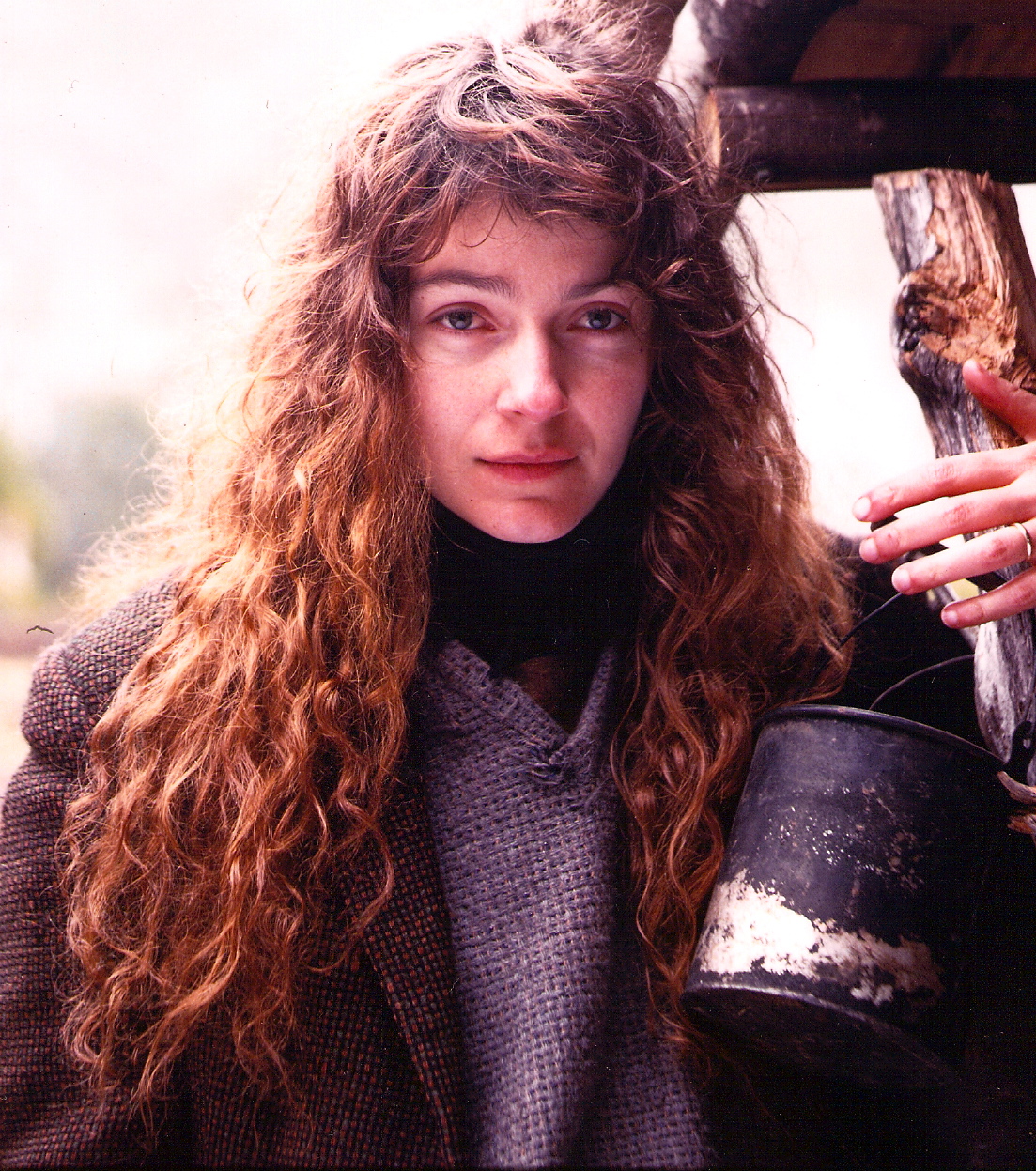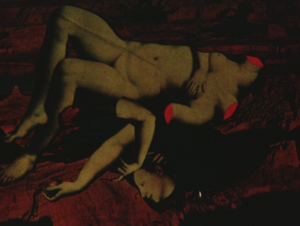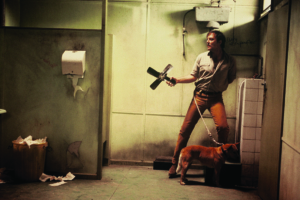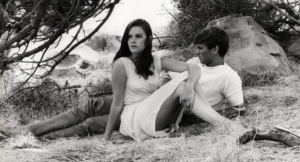Following the second incarnation of Tasmania’s popular midwinter arts festival, Dark Mofo, many were left intrigued by the cold eeriness of Australia’s only island state. Aligning Tasmania’s gloomy reputation with the winter solstice, the Museum of Old and New Art’s seminal event included a range of visual and performing arts, Bacchanalia-inspired seasonal feasts, and contemporary and experimental music. There was also a curated cinema program, Dark Mofo Films, whose thematic focus was definitely dark – featuring, among others, David Michôd’s brutal outback film, The Rover (2014); Iain Forsyth and Jane Pollard’s ficto-documentary about goth-grunge icon Nick Cave, 20,000 Days on Earth (2014); and a live performance of Jed Kurzel’s haunting score to the ‘Bodies in Barrels’ murder film Snowtown (Justin Kurzel, 2011).
While Dark Mofo undoubtedly celebrates Tasmania’s dreary reputation, its film program neglected to showcase the growing corpus of works representing Tasmania itself. Surprisingly, the only Tasmanian content in Dark Mofo Films was Jonathan auf der Heide’s short Hell’s Gates (2008), which formed the basis for his debut feature, Van Diemen’s Land (2009). Both films tell the gruesome tale of notorious Tasmanian cannibal convict Alexander Pearce, who ate several of his companions during two stints on the run from the remote penal settlement in Macquarie Harbour in the early 1800s. Van Diemen’s Land is the fourth long-form film on Pearce, after the documentary Exile in Hell (Barrie Dowdall, 2007), the hillbilly horror-thriller Dying Breed (Jody Dwyer, 2008), and the ABC docudrama The Last Confession of Alexander Pearce (Michael James Rowland, 2008). Together with the screen adaptation of Julia Leigh’s moody novel, The Hunter (Daniel Nettheim, 2011), these films indicate a renewed cinematic attention on Tasmania, its dark and troubling colonial past, and its stark and unforgiving geography.[1]Emily Bullock, ‘Rumblings from Australia’s Deep South: Tasmanian Gothic On-screen’, Studies in Australasian Cinema, vol. 5, no. 1, 2011, p. 72.
Tasmanian Gothic has become the term of choice for this unsettling set of tropes, which are becoming increasingly prevalent in cinematic depictions of Tasmania. The label embodies a hybrid vision of stylistic, thematic, historical and geographical elements, and refers not simply to productions by Tasmanian filmmakers but also to broader screen representations of Tasmania by interstate and international crews. As this essay will argue, Gothic cinematic representations of Tasmania are yoked by a number of persistent concerns, notably the island’s intractable landscape and the overwhelming influence of Tasmania’s past on the present. Together, these concerns create films infused with a sense of melancholy and a haunting, claustrophobic mise en scène.
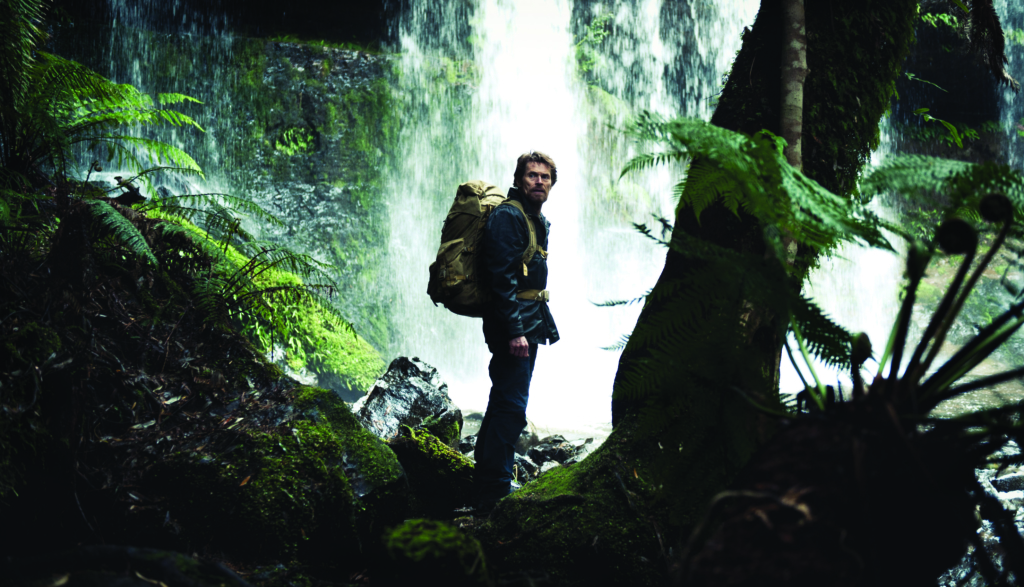
The Gothic of Australia’s deep south
In terms of its topography and its physical distance from the rest of Australia, Tasmania presents a counterpoint to the dry, flat and seemingly infinite landscapes of the mainland, which have been a dominant feature in Australian cinema.[2]Ross Gibson, South of the West: Postcolonialism and the Narrative Construction of Australia, Indiana University Press, Bloomington, 1992, p. 14. In mainland Australian Gothic cinema, it is often the open expanses of the outback – as, for example, in Walkabout (Nicolas Roeg, 1971), Wake in Fright (Ted Kotcheff, 1971) and Wolf Creek (Greg McLean, 2005) – or the ugly, quotidian settings of suburbia (Bad Boy Bubby, Rolf de Heer, 1993; and The Boys, Rowan Woods, 1998) that pose a claustrophobic threat.[3]David Thomas & Garry Gillard, ‘Threads of Resemblance in New Australian Gothic Cinema’, Metro, no. 136, 2003, p. 42. In contrast, Tasmanian Gothic cinema tends to respond to the island’s dark and wet landscapes, which register a paradoxical sense of both beauty and menace. The dramatic inclines of Tasmania’s topography, its volatile climate, together with the dense temperate forest that covers over half of the state, form a forbidding mise en scène suggestive of a Gothic sublime. This aesthetic appears to parallel the sinister cinematic vistas of New Zealand and Scotland, both of which have developed their own versions of cinematic Gothicism.[4]See Ian Conrich, ‘Kiwi Gothic: New Zealand’s Cinema of a Perilous Paradise’, in Steven Jay Schneider & Tony Williams (eds), Horror International, Wayne State University Press, Detroit, 2005; and Duncan J Petrie, Contemporary Scottish Fictions: Film, Television and the Novel, Edinburgh University Press, Edinburgh, 2004.
The broodiness of the Tasmanian landscape is a common trope in Tasmanian Gothic cinema; there is a sense that the landscape harbours and shrouds the secrets of pasts not easily admitted. This dark geography can be seen, for instance, in The Hunter, which revolves around a mercenary character, Martin (Willem Dafoe), hired by a biotech company to gather samples of the ‘last’ Tasmanian thylacine so that it can be cloned. As Rjurik Davidson has argued, the ‘verdant rainforests, windswept wetlands and craggy mountains lend a sense of isolation that mirrors Martin’s own internal landscape’.[5]Rjurik Davidson, ‘The Melancholy Wild: The Hunter’s Landscape of Loss’, Metro, no. 170, Spring 2011, p. 32. In the film, the thylacine is a haunting, seething presence, ghostlike; it is everywhere yet nowhere to be seen. Then, at the very end of the film, it is shot – invoking the violence the species has faced due to human intervention, and embodying an act of mercy as it is rescued from being a mere specimen for the biotech company. The insurmountable loss conveyed everywhere in the filmic landscape – not only in the search for an animal that is extinct in the extradiegetic world, but also in the film’s foregrounding of violent debate over the clearing of Tasmanian forests – exemplifies our palpable guilt and discomfort about a violent postcolonial culture and indicates Tasmanian Gothic’s ability to evoke an ‘ecological sensibility’.[6]Jane Stadler, ‘Seeing with Green Eyes: Tasmanian Landscape Cinema and the Ecological Gaze’, Senses of Cinema, issue 65, November 2012, <http://sensesofcinema.com/2012/65/seeing-with-green-eyes-tasmanian-landscape-cinema-and-the-ecological-gaze/>, accessed 28 May 2014.
The broodiness of the Tasmanian landscape is a common trope in Tasmanian Gothic cinema; there is a sense that the landscape harbours and shrouds the secrets of pasts not easily admitted.
The omnipotent presence of the landscape is frequently linked with Tasmanian Gothic cinema’s excessive preoccupation with the state’s past, which is popularly believed to be bloodier than elsewhere in Australia. Notably, Marcus Clarke’s exemplary Tasmanian Gothic text, For the Term of His Natural Life – which was adapted into films by Charles MacMahon in 1908 and Norman Dawn in 1927 as well as into a miniseries by Rob Stewart – acts as an enduring source of knowledge about the convict era. Both the text and the films convey the harsh, desolate loneliness of convict life in Van Diemen’s Land and establish its reputation as a hellish natural prison at the ‘end of the world’. Dawn’s film in particular depicts the grim penal settlements of Port Arthur and Macquarie Harbour as places where convicts are brutalised as much by prison guards as by the extremities of weather and topography. In this way, Dawn’s film set a precedent for Tasmanian Gothic cinema by harnessing Tasmania’s dramatic natural features – its jagged capes, blowholes and clefts – to melodramatic effect. The landscape surrounding the settlement is shown by the film as complicit with the harsh rhythms of the penal system. This brutality is then bolstered by Dawn’s use of angular silhouettes and elongated shadows redolent of German expressionist cinema, particularly Fritz Lang’s Metropolis (1927). The character of Gabbett, modelled on Alexander Pearce and played by Arthur McLaglen, is For the Term of His Natural Life’s monster figure, with a huge protruding jaw overcrowded with sharp teeth – a Gothic sensationalism that is later continued by Dying Breed.
For the Term of His Natural Life has become a sort of template for Tasmanian Gothic storylines about dealing with past traumas and the brutality of convict life, especially via the iconic figure of Pearce. In the case of Dying Breed, Pearce’s descendants are portrayed as cannibal hillbillies living in the wilds of contemporary Tasmania, sustaining themselves by eating naive mainlanders who travel to Tasmania in search of the thylacine. But the film also taps into popular Gothic images of Tasmania as a place of inbred, two-headed grotesques via its numerous references to convict throwbacks and limited gene pools, and its intertextual allusions to notable American grotesque film Deliverance (John Boorman, 1972).
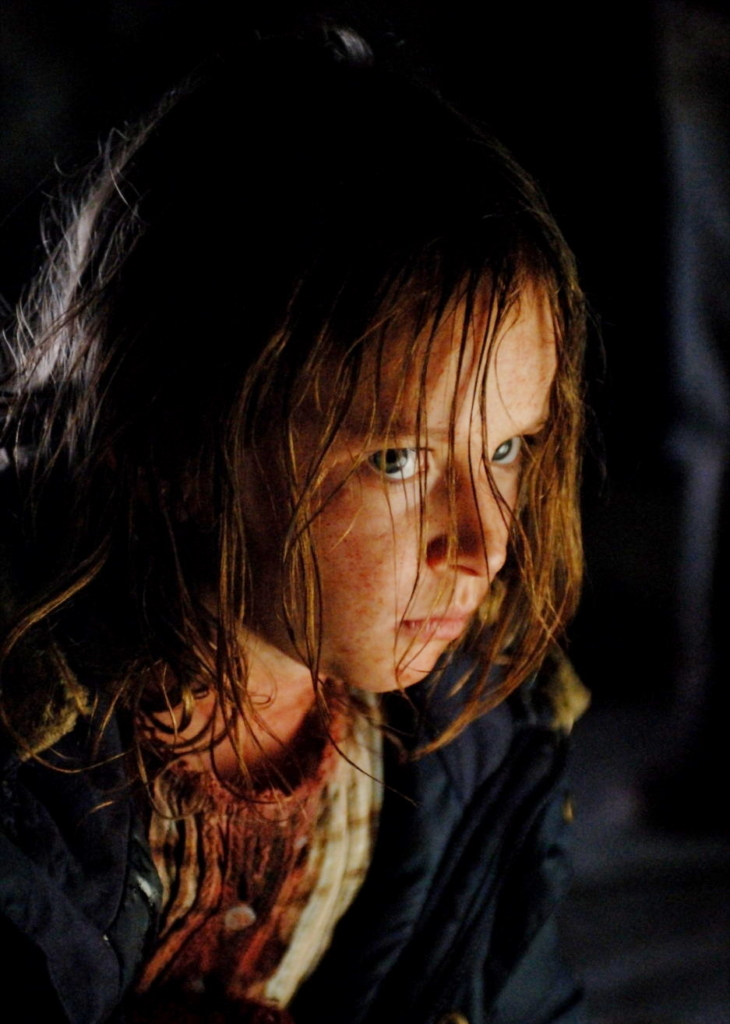
Whereas Dying Breed appears to explicitly incorporate every Tasmanian Gothic image and association in its twisted and schlocky plotline, Van Diemen’s Land is by contrast quietly ominous. It puts greater emphasis on the gruelling monotony of Pearce’s first journey, which was marked by frequent downpours and snow; on the horrific events that took place along the way; and on the unforgiving hell of the wilderness, which, in the film, becomes a character in its own right.[7]Bullock, op. cit., p. 75. The warped violin score by Jethro Woodward and the screeching of the Tasmanian devil heighten the evocation of both menace and melancholy in a place far away from civilisation. Tracking shots peer into the cold, blue-washed wilderness, capturing the land’s malevolence and foreboding the brutal scenes in which the characters kill and eat one another. The tension between the characters as they keep watch over the campfire or stave off sleep is agonising, and is broken only by the thud of the axe wielded by Robert Greenhill (Arthur Angel) or, more reluctantly, by Pearce (Oscar Redding) himself. The violence, however, is for the most part suggested; the film’s power lies in its restraint.
Explaining the reasoning behind his film’s title, auf der Heide says: ‘Not long after Pearce was hanged, the colony wanted a rebirth and to forget its convict heritage. With our film I’m hoping to bring that skeleton back out of the closet’.[8]Jonathan auf der Heide, quoted in Emily Bullock, ‘Strange Silence in Van Diemen’s Land: An Interview with Jonathan auf der Heide’, Metro, no. 162, Spring 2009, p. 41. Indeed, as Van Diemen’s Land and the more widespread interest in Pearce shows, Tasmania’s brutal convict past and the power of its sinister natural environment continues to resonate beyond the state’s borders.
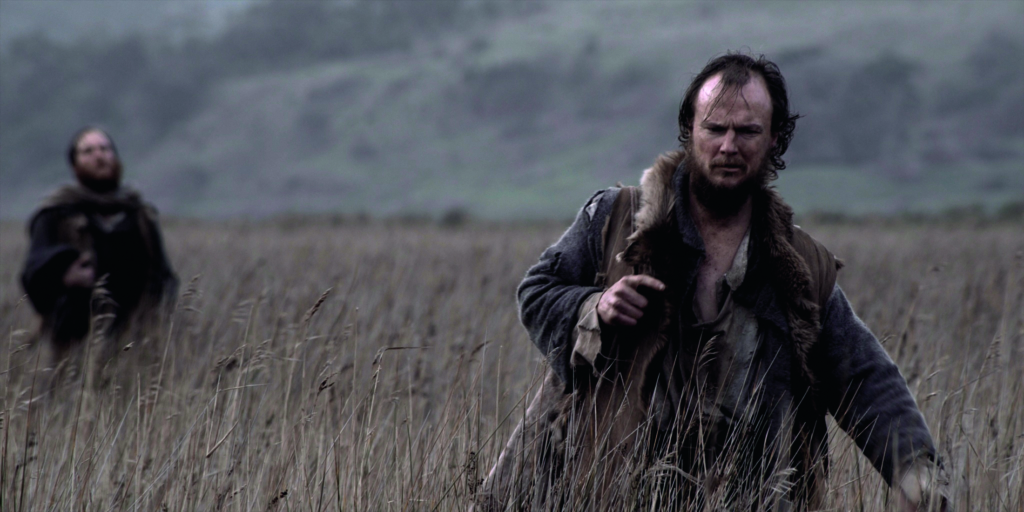
The Tale of Ruby Rose
Roger Scholes’ The Tale of Ruby Rose (1987) offers a unique take on the Tasmanian Gothic. Thematically, the film is consistent with the genre’s focus on marginalised characters, vernacular histories and a repressed past that ‘returns’. Its dark, moody landscapes and expressionistic visual style also cement its place in the Tasmanian Gothic canon. But, unlike the more typical Tasmanian Gothic fascination with Tasmania’s collective colonial past, the film focuses on the more private quest of the film’s female protagonist, Ruby Rose (Melita Jurisic), whose arduous trek back to her home town of Bothwell uncovers past secrets that enable her to continue living in the remote highlands of central Tasmania. The film is based on the folklore and oral histories of animal trappers from the highlands;[9]Paul Kalina, ‘The Trail of Ruby Rose’, Metro, no. 76, May 1988, p. 40. as Scholes explains: ‘I was attracted to notions of history that didn’t fit into the landscape. The colonial world didn’t really interest me.’[10]Roger Scholes, quoted in Paul Byrnes, ‘Curator’s Notes’, ‘The Tale of Ruby Rose’, australianscreen, <http://aso.gov.au/titles/features/the-tale-of-ruby-rose/notes/>, accessed 28 May 2014. This fascination results in a peculiarly ‘eccentric’ filmic vision – one that is more akin to European or New Zealand cinema and, in particular, Vincent Ward’s film Vigil (1984) – and has effectively relegated the film to the margins of later Australian film history.[11]Susan Dermody, ‘The Company of Eccentrics’, in Susan Dermody & Elizabeth Jacka (eds), The Imaginary Industry: Australian Film in the Late ’80s, Australian Film Television and Radio School, North Ryde, 1988, p. 152. This eccentricity is reflected in the film’s limited circulation at the time: the film only received a limited release, and few Australians, or indeed Tasmanians, have ever seen or heard of the film. This was despite the film’s attention from critics: at the 1987 AFI Awards, it was nominated for Best Picture and Best Director, and Paul Schutze won Best Original Music Score;[12]Byrnes, op. cit. at that year’s Venice Film Festival, it was awarded four prizes including the Critics’ Prize for Film Direction, the Elvira Notari Prize, the Pasinetti Award for Best Actress, and Best Original Music.[13]Screen Australia, ‘Info Guide: Information for Filmmakers’, September 2008, <http://www.screenaustralia.gov.au/getmedia/51f13607-60a4-4bec-a8ed-b7a450da313f/InfoFilm.pdf>, accessed 25 July 2014. Thus, until the late 2000s, when it was restored as part of the National Film and Sound Archive of Australia’s Deluxe/Kodak collection, the film was in danger of slipping into film-history oblivion.
As in Van Diemen’s Land, the landscape here functions like a character that plays a powerful role in the lives of the other protagonists; in typical Tasmanian Gothic fashion, Ruby Rose depicts humans as vulnerable and dwarfed by the enormity of the landscape.
The film revolves around the naive Ruby, her husband, Henry (Chris Haywood), and their adopted son, Gem (Rod Zuanic), who eke out a living trapping wallabies for their pelts and meat. More specifically, it follows Ruby’s quest to cure her fear of the dark, which stems from a repressed childhood trauma involving a Tasmanian devil appearing in her cot – information that her father had withheld from her. Only after her onerous journey back to her childhood home in the valley does she discover this explanation, along with the fact that she had a mother who died when she was a baby.

The darkness that Ruby fears signifies the past that, as in many Tasmanian Gothic films, refuses to be laid to rest. This haunting, along with the alien and brooding landscapes of the central highlands, reinforce one another and create an intensity that feeds off and into Ruby’s psychological world, which is then further buttressed by dramatic imagery reminiscent of European arthouse cinema. As in Van Diemen’s Land, the landscape here functions like a character that plays a powerful role in the lives of the other protagonists;[14]Jim Davidson, ‘Tasmanian Gothic’, Meanjin, vol. 48, no. 2, Winter 1989, p. 319. in typical Tasmanian Gothic fashion, Ruby Rose depicts humans as vulnerable and dwarfed by the enormity of the landscape. The film’s opening aerial cinematography ‘depicts scenery that is vast and overwhelming in proportion to the ant-like human enterprise within it’.[15]Cynthia A Freeland, ‘The Sublime in Cinema’, in Carl Plantinga & Greg M Smith (eds), Passionate Views: Film, Cognition, and Emotion, The Johns Hopkins University Press, Baltimore, 1999, p. 71. The mountains are a foreboding presence compared to the characters, particularly Ruby, whose lives are replete with grounded domesticity. Henry’s attempt to build his Babel-like ‘dream home’, which would keep them secure in the inhospitable environment, appears futile, as he is dwarfed by mountains and engulfed by snow. The sense of menace and powerlessness is then heightened by a soundscape punctuated by the piercing shrieks of fauna – a currawong, a Tasmanian devil, a possum and goats.[16]Indeed, the brutal environmental conditions documented in Ruby Rose were mirrored in the film’s production process: ‘at one stage, cast and crew were snowed in for several days. In the end they were forced to trap wallabies to eat, using the wallaby snares which had been made up as props’; see Stephen Thomas, ‘Jewelled Nights’, Island, no. 68, Spring 1996, p. 49.
The darkness that, in Ruby’s words, ‘creeps back in’ represents the past that has been repressed … The rupture that this ‘creeping’ produces renders interior and exterior worlds fluid, so that the ‘darkness’ in and of the past manifests itself in the sinister present landscape – itself an external extension of Ruby’s interior world that, at the same time, actively constructs her subjectivity.
Much like the wilderness of Van Diemen’s Land, which appears to force the characters into a state of madness, the isolation here compels Ruby to turn inward on herself. The cacophony of the landscape suggests an ecology that speaks a language that is foreign to Ruby, who is left alone to dry the wallaby skins collected by Henry and Gem and is shown to flee the hut in fear at the sight of them. Ruby’s techniques to ‘keep the dark at bay’ suggest the presence of malevolent supernatural powers in the landscape. Ruby believes the world to be flat, ‘like a plate’, and the cause of darkness to be the sun’s loss of its battle against the dark. Believing the dark to be against her, Ruby ‘scours’ darkness from the inner recesses of the house by sprinkling flour throughout it, painting its interior walls white, and reciting incantations while Henry and Gem are away snaring. Ruby’s animist, primordial view of light and darkness counters Henry’s rationalism; as Ruby’s voiceover declares:
Henry knows all about the Earth, but he doesn’t understand the fight between day and night. He’s closed up his mind. He sees only what he can get hold of.
Ruby’s worldview demands that we engage with ‘psychic chiaroscuro where plain sight is constantly menaced by flickerings from other worlds’;[17]David Punter, ‘Introduction: Of Apparitions’, in Glennis Byron & David Punter (eds), Spectral Readings: Towards a Gothic Geography, Macmillan, London, 1999, p. 4. these ‘flickerings’ embody forms of knowledge that deviate from the rational – knowledges that are traditionally celebrated by the Gothic. The darkness that, in Ruby’s words, ‘creeps back in’ represents the past that has been repressed. Ruby’s nightmares, for example, are presented in the form of flashbacks and thus create a visual depiction of the past bleeding into the present. The rupture that this ‘creeping’ produces renders interior and exterior worlds fluid, so that the ‘darkness’ in and of the past manifests itself in the sinister present landscape – itself an external extension of Ruby’s interior world that, at the same time, actively constructs her subjectivity.
The geographic isolation of Tasmania’s Walls of Jerusalem hence finds its correlate in Ruby’s temporal isolation from her own past. Ruby’s descent to her family’s valley home represents a pursuit of knowledge of the past – a knowledge that has been denied her by both her father and Henry, and which she needs in order to overcome her phobia of the dark. This plotline involves the tropes of the ‘female Gothic’, whose heroine overcomes adversity in a male-dominated environment.[18]See Andrew Smith & Diana Wallace, ‘The Female Gothic: Then and Now’, Gothic Studies, vol. 6, no. 1, 2004, pp. 1–7. Ruby’s only contact with other people has been with men, whose own memories are repressed and whose speech is elliptical. Her illiterate father ‘hardly spoke’ after the death of her mother and, throughout Ruby’s childhood, withheld knowledge about her mother and grandmother. Henry also prohibits Ruby from discussing the past – as Ruby says, ‘Henry hates the past, the valley.’
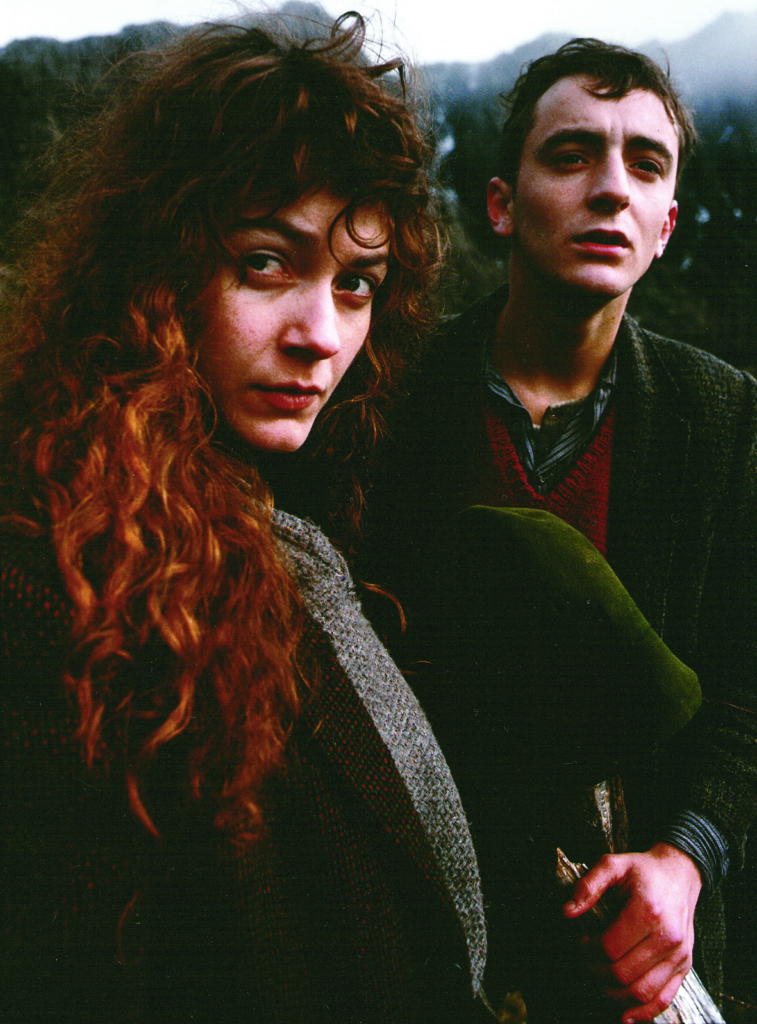
In Bothwell, Ruby learns about the Tasmanian devil she encountered in her cot as a baby; however, a deeper revelation concerning the death of her mother when Ruby was a baby underpins this. In the absence of Ruby’s mother, Ruby’s paternal grandmother (Sheila Florance) usurps the role of mother. In contrast to the harsh highlands, which are coded as ‘masculine’, the home – at least on the surface – represents the feminine, with Ruby and her grandmother sharing a bath. Ruby’s grandmother embodies a feminist consciousness, not only because she knowledgeably teaches Ruby that the Earth is round, thereby explaining the concept of darkness, but also because of her travels to ‘exotic’ places in Africa.[19]Mary Louise Pratt, Imperial Eyes: Travel Writing and Transculturation, Routledge, New York, 1992, p. 5. But this quasi-reunification with the feminine is soon destroyed when Ruby’s grandmother dies in her sleep on the verandah of the home. The feminine and the idea of ‘home’ thus ultimately becomes uncanny or ‘unhomely’ – a place marked by death and to which return is impossible.[20]Sigmund Freud, ‘The Uncanny’, in The Uncanny, trans. David McLintock, Penguin, London, 2003 [1919], p. 151. Ruby must then venture back to the oppressive highlands, both liberated from and longing for her past, and continue her life there.
Through its depiction of isolation and portrayal of a character who must confront the past in order to live in the present, The Tale of Ruby Rose proves itself to be a hallmark text of Tasmanian Gothic cinema. While it enacts this template on a personal level, the film is nevertheless a rejoinder to the broader cultural ambivalence about Tasmania and its past violence.
The genre’s concerns regarding an ominous, overwhelming environment and the haunting of a repressed past run through many cinematic narratives about Australia’s island state. More broadly, the Tasmanian Gothic corpus continues to grow. The recent premiere of Heidi Lee Douglas’ moody short film Little Lamb (2014), a retelling of the Bluebeard fable in Van Diemen’s Land, evidences the Tasmanian Gothic’s enduring power. As Greg Lehman notes, the war that lay at the heart of the state’s founding constitutes Tasmania’s Gothic spectre; in Tasmania:
some dark secrets run so deep that they slip from view. The hole left in our collective conscience is gradually plugged with shallow distractions and awkward half-truths.[21]Greg Lehman, ‘Tasmanian Gothic: The Art of Australia’s Forgotten War’, Griffith Review, no. 39, 2013, p. 201.
It seems there is indeed ‘something’ in Tasmania’s dark past that needs to be reckoned with.
Endnotes
| 1 | Emily Bullock, ‘Rumblings from Australia’s Deep South: Tasmanian Gothic On-screen’, Studies in Australasian Cinema, vol. 5, no. 1, 2011, p. 72. |
|---|---|
| 2 | Ross Gibson, South of the West: Postcolonialism and the Narrative Construction of Australia, Indiana University Press, Bloomington, 1992, p. 14 |
| 3 | David Thomas & Garry Gillard, ‘Threads of Resemblance in New Australian Gothic Cinema’, Metro, no. 136, 2003, p. 42. |
| 4 | See Ian Conrich, ‘Kiwi Gothic: New Zealand’s Cinema of a Perilous Paradise’, in Steven Jay Schneider & Tony Williams (eds), Horror International, Wayne State University Press, Detroit, 2005; and Duncan J Petrie, Contemporary Scottish Fictions: Film, Television and the Novel, Edinburgh University Press, Edinburgh, 2004. |
| 5 | Rjurik Davidson, ‘The Melancholy Wild: The Hunter’s Landscape of Loss’, Metro, no. 170, Spring 2011, p. 32. |
| 6 | Jane Stadler, ‘Seeing with Green Eyes: Tasmanian Landscape Cinema and the Ecological Gaze’, Senses of Cinema, issue 65, November 2012, <http://sensesofcinema.com/2012/65/seeing-with-green-eyes-tasmanian-landscape-cinema-and-the-ecological-gaze/>, accessed 28 May 2014. |
| 7 | Bullock, op. cit., p. 75. |
| 8 | Jonathan auf der Heide, quoted in Emily Bullock, ‘Strange Silence in Van Diemen’s Land: An Interview with Jonathan auf der Heide’, Metro, no. 162, Spring 2009, p. 41. |
| 9 | Paul Kalina, ‘The Trail of Ruby Rose’, Metro, no. 76, May 1988, p. 40. |
| 10 | Roger Scholes, quoted in Paul Byrnes, ‘Curator’s Notes’, ‘The Tale of Ruby Rose’, australianscreen, <http://aso.gov.au/titles/features/the-tale-of-ruby-rose/notes/>, accessed 28 May 2014. |
| 11 | Susan Dermody, ‘The Company of Eccentrics’, in Susan Dermody & Elizabeth Jacka (eds), The Imaginary Industry: Australian Film in the Late ’80s, Australian Film Television and Radio School, North Ryde, 1988, p. 152. |
| 12 | Byrnes, op. cit. |
| 13 | Screen Australia, ‘Info Guide: Information for Filmmakers’, September 2008, <http://www.screenaustralia.gov.au/getmedia/51f13607-60a4-4bec-a8ed-b7a450da313f/InfoFilm.pdf>, accessed 25 July 2014. |
| 14 | Jim Davidson, ‘Tasmanian Gothic’, Meanjin, vol. 48, no. 2, Winter 1989, p. 319. |
| 15 | Cynthia A Freeland, ‘The Sublime in Cinema’, in Carl Plantinga & Greg M Smith (eds), Passionate Views: Film, Cognition, and Emotion, The Johns Hopkins University Press, Baltimore, 1999, p. 71. |
| 16 | Indeed, the brutal environmental conditions documented in Ruby Rose were mirrored in the film’s production process: ‘at one stage, cast and crew were snowed in for several days. In the end they were forced to trap wallabies to eat, using the wallaby snares which had been made up as props’; see Stephen Thomas, ‘Jewelled Nights’, Island, no. 68, Spring 1996, p. 49. |
| 17 | David Punter, ‘Introduction: Of Apparitions’, in Glennis Byron & David Punter (eds), Spectral Readings: Towards a Gothic Geography, Macmillan, London, 1999, p. 4. |
| 18 | See Andrew Smith & Diana Wallace, ‘The Female Gothic: Then and Now’, Gothic Studies, vol. 6, no. 1, 2004, pp. 1–7. |
| 19 | Mary Louise Pratt, Imperial Eyes: Travel Writing and Transculturation, Routledge, New York, 1992, p. 5. |
| 20 | Sigmund Freud, ‘The Uncanny’, in The Uncanny, trans. David McLintock, Penguin, London, 2003 [1919], p. 151. |
| 21 | Greg Lehman, ‘Tasmanian Gothic: The Art of Australia’s Forgotten War’, Griffith Review, no. 39, 2013, p. 201. |
